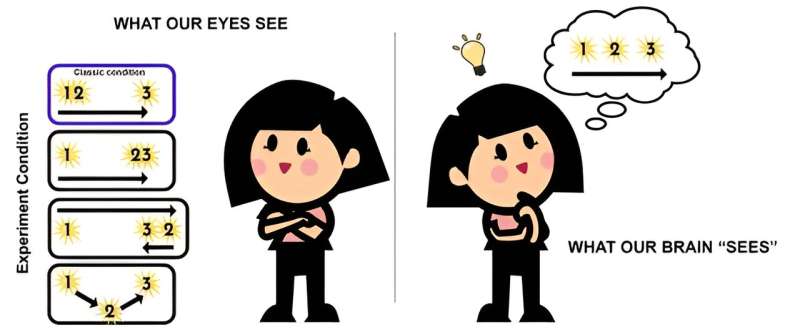Researchers from Kyushu University have uncovered new variations to a traditional illusion, based on how we perceive the motion of flashing lights. Published on May 21 in i-Perception, the findings show that when three light flashes are presented in rapid succession in our side vision, our brain tends to perceive them in a straight line, with the second flash around the midpoint, no matter the actual location of the second flash. This research, which earned the journal’s Early Career Best Paper Prize this year, offers new perspectives on perceptual errors and eyewitness testimony reliability.
For people without severe visual impairments, sight is the most vital sense. Yet, the information our eyes provide isn’t always a faithful depiction of reality. One fascinating phenomenon that highlights this is the visual saltation illusion.
When a series of light points flicker rapidly in the peripheral vision, we may mistake their true positions, thinking the flash is jumping from its original location to another spot. It appears as if a rabbit is jumping from one spot to another, which is why it’s also called the “visual rabbit illusion.”
In traditional experiments, this illusion is studied using three flashes that appear in two locations: the first two flashes at the exact same location on the left and the third flash on the right. Under these conditions, an illusion is created as the second flash is perceived roughly halfway between the two points.
But is this the only condition for the illusion to occur? Researchers at Kyushu University decided to experiment by changing the location of the second flash to see if that impacted the illusion. They fixed the first and third flashes in the peripheral vision, modified the flash duration and intervals to ensure the illusion occurred, and then conducted three experiments.
Their findings indicate that participants misperceived the second flash, placing it near the midpoint between the first and last flash. This illusion occurred regardless of whether the second flash was at the same location as the third or even further to the right of the third flash.
“It’s like a rabbit hopping back to the middle after the brain processes it,” comments Sheryl Anne Manaligod de Jesus, the first author of the study and a doctoral student at Kyushu University’s Graduate School of Design.
Additionally, the researchers found that the flashes do not need to be presented in a line for the illusion to happen. Even when the second flash appeared above or below the midpoint, its perceived location still tended to be near the center. This happens because when our visual system receives flashes in rapid succession, the brain processes them as a whole, leading to a perceptual reorganization of the flashes into a simpler, more coherent pattern.
One way to further investigate the visual saltation illusion’s mechanisms is by providing the experimental results to artificial intelligence. Comparing human and AI responses could indicate whether our visual pathways are simpler or more complex than we imagine.

What we “see” is not solely dependent on our vision, it is often a construction of our brain, influenced by attention and memory. This questions the reliability of eyewitness testimony.
“Our brain sometimes uses future events to interpret the past,” says de Jesus, “This is called postdiction, meaning that how we perceive a past event, like the second flash, is influenced by what happens afterward. This results in the fascinating illusion of the flash appearing in a place, where it never really was.”
As the study suggests, our peripheral vision, especially with fast-moving objects, is not completely reliable. Further research into visual saltation illusions is needed to help us better understand visual processing and potentially improve our peripheral vision. After studying how position changes affected the perceived “rabbit,” the team’s next step is to explore how attention impacts the illusion.
Where does the rabbit hop? Or do we see a rabbit or a duck? How much does our brain mislead our sense of the visual world? Despite needing more research to fully understand these illusions, their power to enrich our lives with unique and enjoyable experiences is clear.
As Professor Hiroyuki Ito, the supervisor of de Jesus and the second author from Kyushu University’s Faculty of Design, remarks, “The most important thing is to enjoy the illusions.”
More information:
Sheryl Anne Manaligod de Jesus et al, Retracing the rabbit’s path: Effects of altering the second flash position in the visual saltation illusion, i-Perception (2024). DOI: 10.1177/20416695241254016
Citation:
Research on the visual rabbit illusion takes a leap forward (2024, June 11)
retrieved 11 June 2024
from https://medicalxpress.com/news/2024-06-visual-rabbit-illusion.html
This document is subject to copyright. Apart from any fair dealing for the purpose of private study or research, no
part may be reproduced without the written permission. The content is provided for information purposes only.

